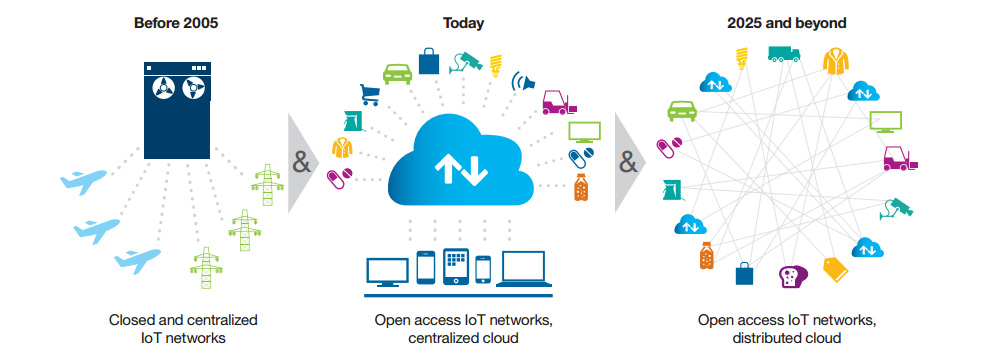
Blockchain seems to be everywhere. With applications in finance, asset management, healthcare, personal identification, and more, wherever there’s a conversation about security, blockchain seems to follow. You’re probably familiar with the terms blockchain and Bitcoin, but do you understand how they actually work? In this article, we’ll give an overview of blockchain, talk about how it works, and talk about what that means for the future of IoT.
To explain blockchain, we’ll refer to Anders Brownworth’s excellent video and interactive demo on his website.
Summary of the Video – Blockchain Explained
Mr. Brownworth starts with hashes and adds onto that concept to explain a distributed peer-to-peer network:
- Hash: Some data is mapped to a seemingly random string for basic encryption.
- Block: A block adds a nonce field to the hashed data to introduce a concept of “signed” or “valid” hashes (in his example, the hash must start with 4 zeros).
- Blockchain: As the name suggests, a blockchain is a chain of blocks. A change in a block higher up the chain affects all of its trailing blocks.
- Distributed Blockchain: Copies of each blockchain are stored by multiple peers. Any changes in the chain is broadcast to everyone in the network, and the change must be approved by the network.
- Tokens & Coinbases: For a practical example, let’s see how cryptocurrency (Bitcoin) works with blockchain. When A wants to send money to B, a block is created to represent that transaction. This new change is broadcast to all the peers in the network, and if approved by the peers, the new block is added to the chain, completing the transaction. The popularity and the controversy surrounding Bitcoin skewed the general perception of blockchain as a technology limited to cryptocurrency application.

So, What Does This Mean for IoT?
Blockchain has other uses outside of Bitcoin and financial transactions because it can act as a ledger for any kind of digital exchange. Dubbed “altchains,” new applications such as Namecoin, which keeps a record of DNS namespace, and Datacoin, which stores data in the blockchain, have sprung up using the underlying Bitcoin software.
As the IoT ecosystem continues to grow, data exchanges and security of those data points will become increasingly important. Perhaps blockchain technology could track data exchanges between sensors/devices to other devices, gateways, or end-users.
The automatic nature of blockchain then could enable even smarter machines. Right now, we have dash buttons to automate our eCommerce experience. But imagine a smart washing machine that can keep a history of its own stock, compare the prices of new detergent from multiple vendors, and pay for the delivery of the detergent on its own.
Or a smart home that keeps a history of all the data flows between the dishwasher, vacuum system, HVAC, and solar panels to optimize for electricity usage and cost.
Finally, blockchain can also push predictive maintenance to the next level, where now the computer not only determines when its parts might fail but can also schedule and pay for that maintenance automatically.
Blockchain frees up centralized systems that are bottlenecked by trusted and centralized human authorities. Each device can act as an independent agent to create a distributed IoT blockchain. According to IBM Institute for Business Value, blockchain or any decentralized IoT solution can support three foundational types of transactions:
- Trustless peer-to-peer messaging
- Secure distributed data sharing
- A robust and scalable form of device coordination

Blockchain and a Distributed Future
Blockchain, with all of its controversies, has barely scraped the surface of its possible use. As blockchain begins to bleed into new verticals and industries, we may see a huge improvement in how IoT networks communicate currently.
It’s still early days in the application of blockchain to IoT, but there’s certainly some promise and if it works, it could be a disruptive force that finally solves the security issues that are hampering IoT growth.
Looking for blockchain and IoT applications? Find out how IoT and Blockchain is changing the construction industry here.
Originally published February 13, 2018. Updated January 29, 2020.





 New Episode
New Episode





 Latest IoT News
Latest IoT News








